
Kid Icarus is a platform video game developed and published by Nintendo for the Family Computer Disk System in Japan and the Nintendo Entertainment System in Europe and North America. It was released in Japan in December 1986, in Europe in February 1987, and in North America in July.

Shigeru Miyamoto is a Japanese video game designer, producer and game director at Nintendo, where he serves as one of its representative directors as an executive since 2002. Widely regarded as one of the most accomplished and influential designers in video games, he is the creator of some of the most acclaimed and best-selling game franchises of all time, including Mario,The Legend of Zelda, Donkey Kong, Star Fox and Pikmin. More than 1 billion copies of games featuring franchises created by Miyamoto have been sold.

Donkey Kong Country 3: Dixie Kong's Double Trouble! is a 1996 platform game developed by Rare and published by Nintendo for the Super Nintendo Entertainment System (SNES). It was released in November 1996 in North America and Japan, and on 13 December in Europe and Australia. It is the third installment of the Donkey Kong Country series and serves as a direct sequel to Donkey Kong Country 2: Diddy's Kong Quest. It was also re-released for the Game Boy Advance (GBA) in 2005. The game was made available to download on the Wii's Virtual Console service in 2007, as well as for the Wii U's Virtual Console in 2014.

The Legend of Zelda: A Link to the Past is an action-adventure game developed and published by Nintendo for the Super Nintendo Entertainment System. It is the third game in The Legend of Zelda series and was released in 1991 in Japan and 1992 in North America and Europe.
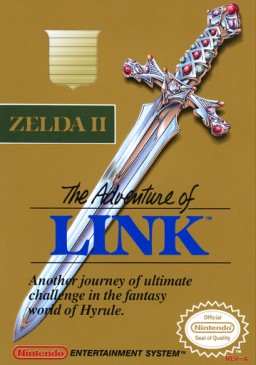
Zelda II: The Adventure of Link is an action role-playing video game with platforming elements developed and published by Nintendo. It is the second installment in the Legend of Zelda series and was released in Japan for the Famicom Disk System on January 14, 1987—less than one year after the Japanese release and seven months before the North American release of the original The Legend of Zelda. Zelda II was released in North America and the PAL region for the Nintendo Entertainment System in late 1988, almost two years after its initial release in Japan.
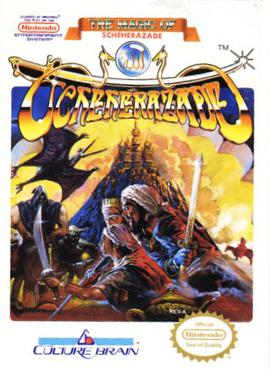
The Magic of Scheherazade is an action-adventure/role-playing video game (RPG) developed and released by Culture Brain for the Nintendo Entertainment System (NES). The game was released in 1987 in Japan and 1990 in North America. The plot is based on Middle Eastern folktales found in One Thousand and One Nights. It involves an amnesic hero traveling through time in an attempt to rescue the princess Scheherazade from the evil wizard Sabaron, who has summoned a horde of demons to bring chaos to the once peaceful land of Arabia. The Magic of Scheherazade is divided into chapters and incorporates elements of both action-adventure and RPG gameplay styles. In each chapter, the player character can freely explore an overworld in a top-down perspective. The player engages hostile enemies with various weapons and spells through both real-time solo action on the overhead map and random, turn-based battles fought alongside befriended allies.

Adventures of Lolo is a puzzle video game released in 1989 by HAL Laboratory for the Nintendo Entertainment System. It is a compilation of puzzles from Eggerland: Meikyū no Fukkatsu and Eggerland: Sōzō he no Tabidachi. It is the fifth game in the Eggerland series, the third one released in Europe, but the first one released in North America. It was available on the Wii's and Wii U's Virtual Console in North America and in PAL regions, as well as on the Nintendo Switch Online's virtual Nintendo Entertainment System library.

Adventures of Lolo 2 is a puzzle video game released in 1990 by HAL Laboratory for the Nintendo Entertainment System. It is the seventh installment of the Japanese Eggerland video game series. It was the fourth game released in European countries and the second one released in the United States and Canada, but was never released in Japan.
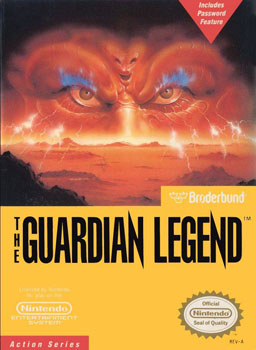
The Guardian Legend is a 1988 hybrid action-adventure/shoot 'em up video game developed by Compile for the Nintendo Entertainment System (NES). It is the sequel to the 1986 MSX game Guardic, and was published and released in Japan by Irem in 1988, in North America by Broderbund in 1989, and in Europe by Nintendo in 1990.

Fire Emblem Gaiden is a tactical role-playing game developed by Intelligent Systems and published by Nintendo for the Famicom. Released in March 1992, it is the second installment in the Fire Emblem series and the last to be developed for the Famicom. It builds upon the basic turn-based strategy gameplay of the previous title, while including new elements such as a navigable overworld. Set in the same world as its predecessor, Fire Emblem: Shadow Dragon and the Blade of Light, Gaiden follows the battles of two opposing armies on the continent of Valentia, which is torn apart by political strife involving the princess Celica and her childhood friend Alm.
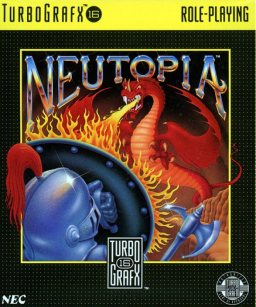
Neutopia is an overhead action-adventure video game developed by Hudson Soft. It was released by Hudson for the PC Engine in Japan on November 17, 1989. It was then released by NEC for the TurboGrafx-16 in North America in 1990. It was re-released for the Virtual Console service worldwide for the Wii in 2007; it was re-released for the PlayStation Network in Japan in 2010 and in North America in 2011. It was re-released for the Wii U on April 16, 2014 in Japan, and in USA and Europe in 2017. The game takes place in the land of Neutopia, where the evil demon Dirth has captured Princess Aurora and has stolen the eight ancient medallions which contain the wisdom and power necessary to maintain peace and prosperity throughout the land. It is up to the protagonist Jazeta to retrieve the eight medallions, defeat Dirth, rescue Princess Aurora, and save the land and its people.
The Eggerland (エッガーランド) series consists of several puzzle games developed by HAL Laboratory. Its first release was in 1985 for MSX computer systems. The gameplay is almost exactly the same across the series, with only a few changes over the years, mainly graphical.

Adventure Island 3 is a side-scrolling platform game published by Hudson Soft that was originally released for the Nintendo Entertainment System in 1992. It is the third game in the Adventure Island released for the NES, following Adventure Island II. Unlike the first two games in the series, the NES version was never released in Europe. A portable version was also released for the Game Boy in 1993 titled Takahashi Meijin no Bouken Jima III, renamed to Adventure Island II: Aliens in Paradise outside of Japan.
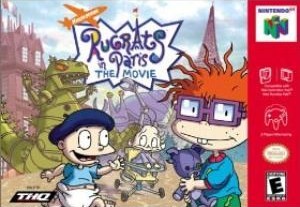
Rugrats in Paris: The Movie is a video game based on the 2000 animated movie of the same name. The game follows the adventures of the Rugrats in a European theme park. A console version of the game was released in 2000, for the PlayStation, Nintendo 64, and a handheld version for Game Boy Color. A version for Microsoft Windows was later released in 2001. The console version's gameplay is similar to Rugrats: Studio Tour, but Paris’ attractions sometimes have minigames too. The handheld gameplay is a side-scrolling platformer. The Windows version's gameplay is an adventure game in which the player must find Chuckie's Wawa Bear.

True Lies is a top-view run and gun video game based on the 1994 film True Lies. The game was developed by Beam Software and published by Acclaim Entertainment. Four different versions of the game were released for the Super Nintendo Entertainment System, Sega Genesis, Game Gear, and Game Boy. The home versions and portable versions are drastically different from each other, but have similar play mechanics.
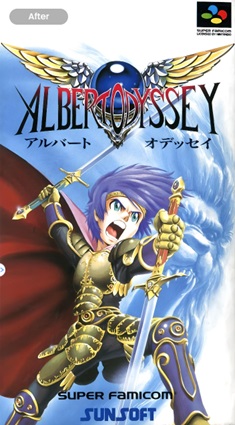
Albert Odyssey is a tactical role-playing video game developed and published by Sunsoft and released for the Super Nintendo Entertainment System in Japan in March 1993. The game features strategy-based combat in addition to traditional role-playing game elements in two-dimensional environments. It is the first game in the Albert Odyssey series, and was followed by two sequels, Albert Odyssey 2: Jashin no Taidou in 1994, and Albert Odyssey: Legend of Eldean in 1996. On June 12, 1996, Albert Odyssey was made available as a full game download on the Satellaview add-on as BS Albert Odyssey, and the original Albert Odyssey was re-released for Satellaview in March 1998.

Kwirk, known in Japan as Puzzle Boy, is a puzzle video game developed and published by Atlus in Japan on November 24, 1989, for the Game Boy. The game was later published in North America in March 1990 by Acclaim Entertainment.

Amazing Tater, known in Japan as Puzzle Boy II (パズルボーイII), is a puzzle video game for the Game Boy developed and published by Atlus. The game features a password system. It is the sequel to Kwirk.

Racket Attack is a 1988 professional tennis Nintendo Entertainment System game. It was released in Japan as Moero!! Pro Tennis (燃えろ!!プロテニス), which the second game of the Moero!! sports series. The gameplay takes place in a ¼ overhead view tennis court with the score being present at all times and an audience of spectators being shown in multiple colors. The North American version features an endorsement from Wilson Sporting Goods. The game was released fairly late in the NES life cycle in Europe and the PAL regions, as available sources show, due to the lengthy process of distributing and the fact that Nintendo have still just started to get into the region by the time of the Japanese release of the game.
Paper Mario is a video game series and part of the Mario franchise, developed by Intelligent Systems and produced by Nintendo. It combines elements from the role-playing, action-adventure, and puzzle genres. Players control a paper cutout version of Mario, usually with allies, on a quest to defeat the antagonist, primarily Bowser. The series consists of six games and one spin-off; the first, Paper Mario (2000), was released for the Nintendo 64, and the most recent, Paper Mario: The Origami King (2020), for the Nintendo Switch.

















